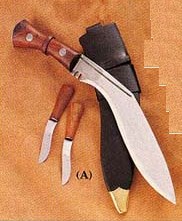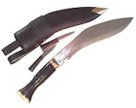 |
Versatile Khukuris
from Gurkha House and Atlanta Cutlery |
 |
|
|
|
|
CRUFFLER.COM
presents
ACCESSORY
REVIEW,
September
2000:
 |
Versatile Khukuris
from Gurkha House and Atlanta Cutlery |
 |
| The
Khukuri is the traditional knife of the Nepalese people. The heavy,
curved blade is most familiar to westerners as the traditional weapon of
the British Army's Gurkha regiments; the Crown's elite forces composed
of Nepalese tribesmen.
While images of khukuris flashing into battle in the Western Desert and at Monte Cassino associate the blade with modern militaries, the khukuri's origins go back more than 2,000 years , making the khukuri one of the oldest blade forms in the history of the world. There are indications that the blade form was carried to the sub-continent by the troops of Alexander the Great and was adapted by local kamis (Nepalese bladesmiths). In addition to its long history, each feature of the knife carries a cultural meaning. What appears to be a blood |

Image credit: http://www.tx3.net/~howardw/Khukuris/Ghurkas.htm |
A true khukuri is hand crafted by a master craftsman called a Bishwarkama (Bishwarkama means "world maker"). They are Bishwarkamas in both profession and caste. The Bishwarkama begins his training in the family trade at around age 5, when he begins helping his father and grandfather in the shop. He learns to pull the chain on the bellows, gathers charcoal, brings water for the quenching pitcher, and learns the names of tools and procedures. At around 12, the young kami is using the hammer and does much of the pounding of steel that goes on in the shop. (Note: in the Gurkha House shop, children don't do any of the actual forging or hard labor - they do errands, clean-up, etc, but go to school at a nearby school. All Gurkha House bishwakarmas are at least 20 years old.) By this time he can make a few simple farm implements by himself. By the time he is 20 he can produce many items, and even make a decent khukuri by himself but it will often not be perfect. At 30, the kami is still only an apprentice. At around 40, the kami is just about ready for master kami status. At this stage he has made every farm tool that can be made. He can make a perfect khukuri almost every time. He has gained an intimate understanding of metallurgy and steelworking, and it shows in his work.
The best khukuris made to day start their lives as pieces of spring steel, a leaf spring from a truck being almost the ideal raw material. It is then forged, or heated and then beaten into the desired shape. They are specially heat treated so that the cutting portion of the blade is harder than the rest of the knife. This process, called zone hardening, keeps the blade flexible so that it can absorb the shock of impact when being used as a chopping implement, yet maintain an edge for years. Grips may be of wood, water buffalo horn, brass, or aluminum. Khukuri sheaths are made from wood covered with hide.
The khukuri sets off a Cruffler's collection perfectly, providing the perfect accent to any Enfield or Mauser rifle that may have seen service in the Second World War. Additionally, quality khukuris are excellent utility knives that can serve a wide range of uses. With this in mind, CRUFFLER.COM ordered a pair of khukuris, one from Atlanta Cutlery, and one from Gurkha House for evaluation.
INITIAL
INSPECTION
The Atlanta
Cutlery khukuri arrived first. Billed as "The Genuine Gurkha Kukri,"
Atlanta Cutlery assures the buyer that for your $22.95 plus shipping, you
are receiving the only khukuri that is issues to ghurka regiments in India.
The knife has a 12" long blade that is a quarter of an inch thick with
"deep grooves" and
| cho. Overall, the Atlanta Cutlery khukuri is 17" long and weighs 22 ounces. Our first impression was that the knife was, well, a little rough. The blade is polished brightly, taking on a matted appearance toward the last 1.5" before the hilt. It is marked "India," with a broad arrow motif on the left side of the ricasso. The grips are wooden and, while very smooth, are unfinished, and retained with two through rivets, which are polished at the points at which |  |
The scabbard was disappointing. It was made of the traditional hide covered wood. The knife bound excessively during both insertion and extraction, and it was not well fitted to the blade, with approximately three-eighths of an inch exposed when the blade was fully seated in the scabbard. The accessory blades were not adequately secured when fully seated in their compartments, and both the rivets that secured the belt loops to the frog and the brass tip to the scabbard were severly tarnished.
Each khukuri is supplied with two utility blades, the chakmak, and the karda. The chakmak is made from harder, rough steel, and is meant to be used for sharpening the khukuri or as a steel for starting fires. The karda is a sharpened utility knife. Apparently nobody told the Indian government contractor about this, because they supplied our khukuri with two kardas, omitting the chakmak.
Interestingly, the Atlanta Cutlery offering came with a copy of a 1944 blueprint for the British military "Kookrie Mk. 3" as well as what was apparently a copy of a contract between the Indian government for the provision of these knives.
A few days later, the khukuri from Gurkha House arrived. We had ordered the "Service Number One," or SN1 from Gurkha House. For their $69.00 plus shipping
 |
the buyer gets the "actual khukuri (made by the same bishwakarmas) issued to Gurkhas serving with the British Army, the Singapore Police, and the the Gurkha Reserve unit in Brunei." This khukuri is 15" long overall, with a blade of about |
The SN1's blade was as positive as the Atlanta Cutlery's was poor. It was uniformly shaped and sharpened to a near perfect edge that, while suited for chopping, was at home slicing neatly through paper, cloth and plastic, all along the sharpened portion of the blade. The scabbard was also perfect, being a water buffalo hide wrapped wooden affair tipped with brass. The bade fit perfectly, and did not bind on either insertion or extraction. The SN1 came with matching chakmak and karda, both with water buffalo horn grips, that were perfectly fitted and secured in the scabbard.
FIELD TEST
The khukuri's
fighting qualities, chopping ability, metallurgy, and mystique have been
amply chronicled in periodicals such as Blade
and Tactical Knives.
In fact, if you're interested in detailed reporting about those attributes,
we highly recommend that you go to the Gurkha
House Reader's Corner, or do a search for kukri or khukuri on the Web.
After all, we're firearms historians, not knife guys. We know two
things really well: Good guns and good food. And that was the
germ for the idea for our khukuri field testing: For a day we became
the Khukuri Chefs!
Okay, stop laughing. The khukuri is above all, a general purpose utility knife that has been used for centuries by the people of Nepal. Since everyone else has done the "manly man" review, we felt it our due to try something a little more practical, like dinner. Our results are detailed in the tables below.
The Great Khukuri Cook Off
|
|
|
| Beef | We started out with a six pound roast that needed
to be cut into four steaks, as well as some thin strips to be made into
beef jerky. Both blades were compared to a set of professional grade
kitchen knives that had just been sharpened.
Atlanta Cutlery: This blade was beyond useless. It was simply too dull to be an effective cutting tool. Did make a dandy meat tenderizer though. Gurkha House: The SN1 performed beatifully, slicing thin strips and large chunks as well as the restaurant grade kitchen knife. It chopped through bone better than a restaurant grade cleaver. |
| Fish | We used a two pound salmon filet for this trial,
and again pitted both khukuris against restaurant grade kitchen knives.
Atlanta Cutlery: This blade did little more than mash a 1/8" section of the fish into unrecognizeable salmon bits. Gurkha House: The SN1 sliced the salmon perfectly, both with and against the grain of the fish. We were also able to neatly slice skin from the bottom of the filet. Again, the SN1 performed as well as the restaurant grade knife. |
| Poultry | This trial involved a whole chicken that was to
be cooked on the bone.
Atlanta Cutlery: This blade did surprisingly well in hacking the chicken apart, removing wings and legs with only a little more effort than that required by the kitchen blade. Gurkha House: The SN1 hacked effortlessly through the chicken joints, and required only a little bit of effort to go through bare bone. Significantly easier to use than the kitchen blade owing to the heavier khukuri blade. |
| Onions | Atlanta Cutlery:
This khukuri failed to effectively slice or chop onions due to the lack
of a sharp edge to the blade.
Gurkha House: The SN1 sliced slightly less effectively than the kitchen knife owing to its thicker blade. It chopped the onions much more effectively and much more quickly than the kitchen blade. |
| Garlic | Atlanta Cutlery:
While the Atlanta Cutlery offering failed to effectively chop the garlic
due to the lack of a sharp edge, its broad, flat blade provided an ample
surface for crushing garlic.
Gurkha House: Slicing was inhibited because of the blade thickness, but The SN1 again proved to be very effective at chopping. |
| Tomatoes | Atlanta Cutlery:
Ineffective at slicing or chopping tomato slices.
Gurkha House: In effective at slicing, but very effective at chopping sliced tomatoes. |
| Broccoli | Atlanta Cutlery:
Ineffective at slicing or chopping.
Gurkha House: The SN1 proved quite adept at both slicing and chopping broccoli. |
| Potatoes | Atlanta Cutlery:
The Atlanta Cutlery khukuri was able to slice the potatoes, but that had
more to do with the effect of metal on potato than on the effect of any
edge on the steel.
Gurkha House: The SN1 was as effective at both slicing and chopping potatoes as the kitchen knives. |
| Carrots | Atlanta Cutlery:
Ineffective at cutting or chopping.
Gurkha House: The SN1 was as effective at both slicing and chopping carrots as the kitchen knives. |
| Rye Bread | Atlanta Cutlery:
Ineffective at slicing bread.
Gurkha House: The SN1 significantly less effective at slicing bread than the kitchen knives. |
| French Bread | Atlanta Cutlery:
Ineffective at slicing bread.
Gurkha House: The SN1 was able to slice the bread, but significantly less effective at doing so than the kitchen knives. |
| Blue Cheese | Atlanta Cutlery:
This blade cut and chopped blue cheese quite effectively. Then again,
so did a butterknife.
Gurkha House: The SN1 sliced and chopped blue cheese easily and effectively, at least as well as the kitchen knives. |
| Cheddar Cheese | Atlanta Cutlery:
The Atlanta Cutlerly khukuri was not any more effective at slicing cheddar
than an unsharpened piece of steel.
Gurkha House: The SN1 had no problems slicing or chopping cheddar cheese. |
| Swiss Cheese | Atlanta Cutlery:
The Atlanta Cutlerly khukuri was not any more effective at slicing swiss
than an unsharpened piece of steel.
Gurkha House: The SN1 had no problems slicing or chopping swiss cheese. |
CONCLUSION
The khukuri
is, above all, a utility blade. The measure of such a blade is not
merely how well it serves as a weapon, but how many roles it can effectively
fill. While our "cook out" may be amusing, there are serious undertones.
After all, one cooks (or chops or carves) far more often than one engages
in mortal combat, and a blade than cannot serve well in mundane, everyday
tasks is more decoration than too. In this regard, the Service Number
One from Gurkha House excelled. However, this is not to say that
the Atlanta Cutlery khukuri doesn't have a place. If you're looking
for an inexpensive khukuri-like knife to set off a British militaria collection,
the combination of price and appearance is hard to beat. On the other
hand, if you're looking for a working knife, we highly recommend the Service
Number One.
And now, our Buy-O-Meter rating for these products:
Service Number One, all roles:
 |
Atlanta Cutlery Khukuri, as a display only item:
 |